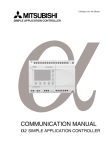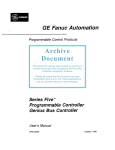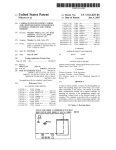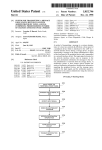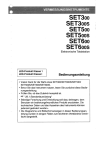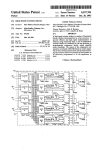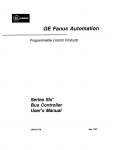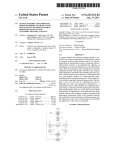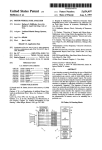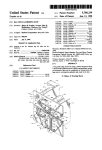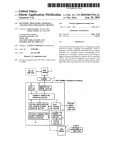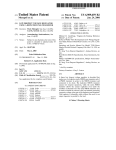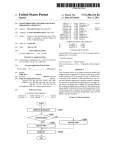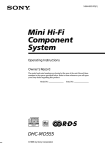Download Adaptive network protocol independent interface
Transcript
USOO5710908A United States Patent [191 [11] Patent Number: Man [45] Date of Patent: [54] ADAPTIVE NETWORK PROTOCOL INDEPENDENT INTERFACE Assistant Examiner-Dan Fiul [75] Inventor: Chiu Ming Man, Anaheim, Calif. Scinto [73] Assignee: Canon Kabushiki Kaisha, Tokyo, Japan [57] 5,710,908 Jan. 20, 1998 Attorney, Agent, or Firm—-Fitzpatrick, Cella, Harper & ABSTRACT Aprotocol independent method of transmitting a data packet [21] Appl. No.: 495,172 from a ?rst application program executing on a ?rst device [22] Filed: which is interfaced to a LAN to a second application [51] Jun. 27, 1995 Int. C15‘ ................................................... .. H04L 29/06 395/500 the LAN. A protocol independent interface (PH) program is Field of Search ............................. .. 395/500, 200.15, initialized which determines which protocols are available for use, assigns an access line to each protocol that is available for use, assigns an access 1]) to the ?rst application program, and creates mapping information that indicates a [52] U.S. Cl. [58] program executing on a second device which is interfaced to 395/200.02, 200.03, 117, 602, 614, 284, 285, 286, 200.19, 200.2, 200.1; 370/389, 401, 455 [56] References Cited one-to-one correspondence between an access lD/access U.S. PATENT DOCUMENTS line pair and a block of protocol speci?c information which includes a protocol header having predetermined address data. A data packet is sent to the P11 program together with 4,855,905 5,182,748 8/1989 Estrada et a1. . 1/1993 Sakata et a1. . 5,305,317 5,321,819 4/1994 Szczepanek . 6/1994 Szczepanek . 5,323,392 6/1994 Ishii et a1. . 5,408,609 5,410,535 4/1995 Malgogne et al. . 4/1995 Yang et a1. . the access 1]) of the ?rst application program and a desti nation 1]) for the second application program, and one of the 5,425,028 6/1995 Britton et a1. ........................ .. 370/389 5,430,727 7/1995 5,491,693 2/1996 Brittonetal. .. 5,491,694 2/1996 5,509,123 4/1996 Dobbins et al. $526,489 6/1996 Nilakantan et al. ............. .. 395000.02 Callon . . ... ... . .. . . . . .. 370/401 370/401 Oliver et a1. . . . . . . . .. 370/455 3950.00.15 OTHER PUBLICATIONS SK-Passport User’s Manual, Syskonnect, Inc., Saratoga, available protocols is selected to transmit the data packet. A block of protocol speci?c information is retrieved from the mapping information based on the access ID of the ?rst application program and the access line corresponding to the selected protocol, and a transmission packet is formed which includes vthe data packet, the destination 1]), and the retrieved block of protocol speci?c information. The trans mission packet is then transmitted via the LAN. CA, 1992. Primary Examiner——Kevin J. Teska 43 Claims, 12 Drawing Sheets 245 PSEHVER I’ 270 25g SNMP |—/ CMIP f. 250 240 l PROTOCOL INDEPENDENT INTERFACE I NETWO HK INTERFACE DRIVER 100j LANiO US. Patent sheet'l of 12 , Jan. 20, 1998 5,710,908 WO RKSTATI ON 110 ._ NED FILE SERVER [1OLAN PSERVER [5O 2 105 l 100 UNIX WORKSTATION MACINTOSH FIG. 1 US. Patent Jan. 20, 1998 Sheet 2 0f 12 245 PSERVER 5,710,908 260 270 SNMP ~01 TX CMIP / f 250 T} PROTOCOL INDEPENDENT INTERFACE 23%| éjz MULTIPLEXER SOFTWARE MODULE I T NETWORK INTERFACE DRIVER 100) LAN 10 FIG. 2 US. Patent Jan. 20, 1998 Sheet 5 of 12 / PH ,1 XPL // MLID / LSL / CNETX ’ PRETASK / 350 N 5,710,908 I ' ‘ IPX/SPX / SAP CPSERVER CRPRINTER FLASH EPROM TCP/IP INTERRUPT \ TIMERTICK \ LPRINTSERVER \ DDP \ CPSOCKET \ MONITOR \ RESIDENT \ POST \ NIF DATA BLOCK FIG. 5 US. Patent Jan. 20, 1998 Sheet 6 of 12 5,710,908 S601 INITIALIZE PII S602 OPEN PH 8603 SEND PACKET TO PII S604 SELECT PROTOCOL TO TRANSMIT PACKET S605 RETRIEVE PROTOCOL SPECIFIC INFORMATION 8606 FORM TRANSMISSION PACKET S607 , TRANSMIT PACKET |—/ I FIG. 6 US. Patent Jan. 20, 1998 Sheet 7 0f 12 FIG. 7A PROTOCOL ACCESS LINE # UDP 1 _ IPX DDP 2 3 FIG. 7B PROTOCOL ACCESS LINE # UDP IPX DDP 2 3 1 FIG. 8A PROGRAM CMIP MANAGER SNMP MANAGER ACCESS ID # XXXX1 XXXX2 FIG. 8B PROGRAM CMIP AGENT SNMP AGENT ACCESS ID # YYYY2 YYYY1 5,710,908 US. Patent Jan. 20, 1998 FIG. 9A ACCESS ID/ACCESS LINE 5,710,908 Sheet 8 of 12 f 902 PROTOCOL SPECIFIC ADDRESS HEADER TYPE ADDRESS IN HEADER xxxx1/1 xxxx1/2 xxxx1/s xxxx2/1 UDP HEADER IPX HEADER DDP HEADER UDP HEADER CMIP PORT CMIP SOCKET CMIP SOCKET/NAME xxxx2/2 XXXX2/3 IPX HEADER DDP HEADER SOCKET 900F/9010 901 ) 903 j PORT 160/161 ‘ SOCKET 8/9 - SNMP AGENT/SNMP TRAP HANDLER 904) FIG. 9B ACCESS ID/ACCESS LINE YYYY1/1 YYYY1/2 YYYY1/3 YYYY2/1 YYYY2/2 YYYY2/3 PROTOCOL SPECIFIC ADDRESS HEADER TYPE ADDRESS IN HEADER DDP HEADER SOCKET 8/9 - SNMP AGENT/SNMP UDP HEADER IPX HEADER DDP HEADER UDP HEADER IPX HEADER TRAP HANDLER PORT 160/161 SOCKET 900F/9010 CMIP SOCKET/NAME CMIP PORT CMIP SOCKET US. Patent Jan. 20, 1998 . 2 0 3 9 RC18n061601 4/0 2 Sheet 9 0f 12 $<v5“¢E29o0m_w:5z2 5.9m: Eomwn dCln IPGZmI 5,710,908 .<2G.E US. Patent Jan. 20, 1998 8£01 Sheet 10 of 12 5,710,908 .UEmow wYv.§E2o<0Ew9z 4/0 0l ? 801Q51‘ EDwXOMI mODZw .m_OvDw U.S. Patent Jan. 20, 1998 Sheet 12 of 12 5,710,908 S1101 INITIALIZE PII S1102 OPEN PII S1103 RECEIVE PACKET FROM LAN S1104 RETRIVE ACCESS lD/ACCESS LINE PAIR FROM MAPPING TABLE S1105 SEND PACKET TO APPLICATION PROGRAM BASED ON ACCESS ID FIG. 11 5,710,908 1 2 ADAPTIVE NETWORK PROTOCOL INDEPENDENT INTERFACE with an IPX protocol stack and a DDP protocol stack, in addition to code to communicate with a UDP protocol stack. Moreover, a CMIP program or any other application will also require the extra code for communicating with different BACKGROUND OF THE INVENTION protocol stacks. As a result, application programs that are 1. Field of the Invention The present invention relates to a method of transmitting data between application programs executing on different designed to support multiple protocols using the conven tional approach require a more complex design, have a longer development time, have less portability, and have a higher maintenance cost than application programs which support a single protocol. Accordingly, a way is needed for application programs to devices interfaced to a local area network and, more particularly, to a method of transmitting data between appli cation programs independent of any speci?c protocol. 2. Description of the Related Art Computerized local area networks (LAN ’ s) are in wide spread use for interconnecting many different computers and communicate with application programs on other network devices independent of a speci?c protocol. peripherals so as to allow users of the computers to com 15 municate with one another and also to allow those users shared access to the peripherals. Recent developments in LAN’s have seen the introduction of so-called “heteroge neous” LAN’s, i.e., LAN ’s on which many different com munication protocols are carried on a single Ethernet or 20 Token-ring medium. Examples of different protocols are IPX, which is typically used by DOS-based PC’s, UDP/IP, which is typically used by UNIX-based workstations, and DDP, which is typically used by Macintosh computers. Each SUNIMARY OF THE INVENTION The above need is addressed by the present invention in which data is transmitted between application programs executing on different devices independent of a speci?c protocol. In a ?rst aspect, the present invention is a protocol independent method of transmitting a data packet from a ?rst application program executing on a ?rst device which is interfaced to a LAN and a second application program executing on a second device which is interfaced to the type of computer or workstation can be adapted through 25 LAN. A protocol independent interface (PlI) program is software to communicate using multiple different protocols. A peripheral also can include software, i.e., multiple protocol stack modules, which allows the peripheral to communicate using multiple protocols in order to be shared initialized which determines which protocols are available for use, assigns an access line to each protocol available for use, assigns an access 1]) to the ?rst application program, and creates mapping information that indicates a one-to-one correspondence between an access ID/access line pair and a on a heterogeneous LAN. A protocol stack is a software module that processes packets of data which are received from or are transmitted to the LAN using the corresponding block of protocol speci?c information which includes a protocol header having predetermined address data. A data protocol. The protocol stacks and the associated lower-level embedded in or attached to the peripheral. The network packet is sent to the PH program together with the access 11) of the ?rst application program and a destination 1]) for the second application program, and one of the available pro tocols is selected to transmit the data packet. A block of interface device serves as an interface which allows the protocol speci?c information is retrieved from the mapping peripheral to communicate with other network devices via the LAN. Network devices, i.e., network interface devices and computers which are interfaced to the LAN,‘ also execute application programs. These programs execute at a level information based on the access ID of the ?rst application program and the access line corresponding to the selected software for network communications are typically stored and executed on a network interface device which may be 35 above the protocol stacks and can include, for example, print server programs, management programs which allow com 45 munication between a computer and a peripheral in order to con?gure or obtain status data from the peripheral, and other programs which may communicate data between diiferent devices interfaced to the LAN. Exemplary management programs include programs that implement SNMP (Simple Network Management Protocol) and CMIP (Common Man protocol, and a transmission packet is formed which includes the data packet, the destination 1]), and the retrieved block of protocol speci?c information. The trans mission packet is then transmitted via the LAN. By virtue of this arrangement, a generic interface is provided between application programs and protocol stacks, so that the protocol used to transmit data between applica tion programs executing on different network devices is transparent, i.e., unknown to the application program. As a 50 result, application programs can be written generally with out including code to handle communication with different agement Information Protocol). More than one such man application programming interfaces for different protocol agement program may be executing on a single network stacks. device at the same time. In another aspect, the present invention is a method of In a conventional approach, an application program com 55 delivering a data packet received from a ?rst application municates with a protocol stack via an application program program executing on a ?rst device which is interfaced to a ming interface (API) and uses the protocol stack to perform local area network (LAN) to a second application program communications services. An application program must use executing on a second device which is interfaced to the diiferentAPIs to interface with each different protocol stack. LAN. A protocol independent data packet is received from the ?rst application program, together with data identifying the ?rst application program and a destination ID identifying the second application program. The protocols available for This means that the application program must be aware of the particular network enviromnent, i.e., the protocol in use, and the speci?c network API to be used. The conventional approach leads to many di?iculties. If use are determined and one of the available protocols is an application program must support multiple network protocols, duplicated e?ort is required for the application software to handle the different APIs. For example, an SNMP program must include software code to communicate 65 selected to transmit the data packet. Protocol speci?c infor mation which includes a protocol header having predeter mined address data is determined based on the data identi fying the ?rst application program and the protocol selected 5,710,908 3 4 in said selecting step. Atransmission packet is then formed which includes the data packet, the destination 1]), and the determined protocol speci?c information, and the transmis sion packet is transmitted to the second application program By virtue of this arrangement, a network device can transmit data from an application program which it executes to an application program executing on another device in such a manner that the protocol used to transmit the data is via the LAN. By virtue of this arrangement, a data packet which is received from one application program without any data specifying a protocol can be transmitted to another applica tion program based only on information identifying the transparent to the application programs. According to still a further aspect, the present invention is a network device which is interfaced to a local area network (LAN) and which receives data that is transmitted from a ?rst application program executing on another device inter source and destination programs received from the one 1O faced to the LAN to a second application program executing on said network device. The network device includes a LAN application program. In yet another aspect, the present invention is a method of receiving data which is transmitted from a ?rst application interface for sending data to and receiving data from the LAN and a storage device which stores the second applica tion program and a protocol independent interface program program executing on a ?rst device which is interfaced to a local area network (LAN) to a second application program executing on a second device which is interfaced to the which (i) determines which protocols are available, (ii) LAN. A protocol independent interface program is initial ized which (i) determines which protocols are available for an access ID to the second application program, and (iv) assigns an access line to each available protocol, (iii) assigns creates mapping information having a one-to-one correspon use, (ii) assigns an access line to each protocol available for use, (iii) assigns a unique access 1]) to the second application program, and (iv) creates mapping information that indicates protocol speci?c information which includes a protocol header having predetermined address data. The network a one-to-one correspondence between an access ID/access device also includes a processor which (i) executes the line pair and a block of protocol speci?c information which includes a protocol header having predetermined address data. A transmission packet is received from the LAN which includes data and a block of protocol Speci?c information dence between an access ID/access line pair and a block of 25 including a protocol header having predetermined address data. The access lD/access line pair which corresponds to the block of protocol speci?c information contained in the received transmission packet is then retrieved from the mapping information, and the data contained in the received transmission packet is sent to the second application pro gram based on the access ID retrieved from the mapping information. By virtue of this arrangement, a received packet can be routed to the correct application program through a generic second application program, (ii) initializes the protocol independent interface program, (iii) receives via said LAN interface a data packet which is transmitted by the ?rst application program and which includes a block of protocol speci?c information, (iv) retrieves an access ID/access line pair from the mapping information which corresponds to the block of protocol speci?c information contained in the data packet, and (v) sends the data packet to the second appli cation program based on the access 1]) retrieved from the mapping information. By virtue of this arrangement. a network device can 35 interface without the need for an application programming interface speci?c to a particular protocol and application program. In still another aspect, the present invention is a network receive data from an application program and route the data to a destination application program in such a way that the protocol used to transmit the data is transparent to the application program receiving the data. As a result, an application programming interface that is speci?c to the protocol and the application program is not needed to 40 receive data. device which is interfaced to a local area network (LAN) and BRIEF DESCRIPTION OF THE DRAWINGS which transmits data from a ?rst application program FIG. 1 is a diagram of a local area network. executing on said network device to a second application program executing on another device interfaced to the LAN. FIG. 2 is a diagram showing the software architecture The network device includes a LAN interface for sending 45 used for communication between application programs data to and receiving data from the LAN and a storage according to the preferred embodiment of the present inven device which stores the ?rst application program and a tion. protocol independent interface program which (i) deter FIG. 3 is a diagram showing the functional relationships mines which protocols are available, (ii) assigns an access line to each available protocol, (iii) assigns an access ID to between software modules executing on a computer and a the ?rst application program, and (iv) creates mapping FIG. 4 is a functional block diagram of a network expan sion board for interfacing a printer to a local area network. network interface device. information having a one-to-one correspondence between an access ID/access line pair and a block of protocol speci?c information which includes a protocol header having pre determined address data. The network device also includes a processor which (i) executes the ?rst application program, 55 (ii) initializes the protocol independent interface program, (iii) processes a data packet which is generated by the ?rst application program by selecting a protocol to transmit the data packet, retrieving a block of protocol speci?c informa application program executing on a second network device. FIGS. 7A and 7B show examples of protocol mapping tables created by protocol independent interfaces. FIGS. 8A and 8B show examples of access ID mapping corresponding to the selected protocol and the access ID of the ?rst application program, and forming a transmission packet including a destination 1]) for the second application, the LAN. FIG. 6- is a ?ow diagram showing process steps for transmitting a data packet between a ?rst application pro gram executing on a ?rst network device and a second tion from the mapping information based on the access line the data packet, and the retrieved block of protocol speci?c information, and (iv) transmits the transmission packet via FIG. 5 illustrates software modules that may be stored in memory on the network expansion board. tables created by protocol independent interfaces. FIGS. 9A and 9B show examples of protocol address 65 mapping tables created by protocol independent interfaces. FIGS. 10A through 10C show examples of transmission packet formats for use with different protocols. 5,710,908 5 6 FIG. 11 is a ?ow diagram showing process steps for receiving a data packet transmitted from a ?rst application packets between network interface driver 210 and one or program executing on one network device to a second more protocol stacks. Each protocol stack receives packets that use the corresponding protocol, determines what needs application program executing on another network device. to be done with the packets, and routes the packets to the DESCRIPTION OF THE PREFERRED EMBODIMENT ferred embodiment supports three protocol stacks: IPX stack 230, UDP stack 231, and DDP stack 232. All of the protocol stacks might not be loaded on a particular device. Further, additional stacks for other protocols may be included. In the appropriate application programs for servicing. The pre [1. System Overview] FIG. 1 is an illustration of a heterogeneous network system including several different types of computers and 10 several different peripherals to which the computers can share access. The present invention can also be used with devices connected to a homogenous network, i.e., a network in which every device uses the same protocol. 15 In FIG. 1, LAN 10 is depicted as an Ethernet medium which has a bus-type architecture, but a Token-ring medium having a ring-type architecture can be used as well. Con preferred embodiment, network interface driver 210, multi plexer software module 220, and protocol stacks 230-232 conform to the Open Data-Link Interface (ODI) speci?ca tion described in “Open Data-Link Interface Developer’s Guide for DOS Workstation Protocol Stac ”, Version 1.10, Released by Novell, Inc., Mar. 18, 1992. A protocol independent interface (PH) 250 serves as an interface between protocol stacks 230-232 and management application programs such as an SNMP application program nected to LAN 10 are a PC 20 which serves as a system 260 and a CMIP application program 270. P11 250 “listens” administrator’s computer, a PC 30 which serves as a print 20 for data packets addressed to particular sockets, i.e., server for printers 85 and 95, a Macintosh computer 40, a UNIX workstation 50, and a generalized workstation 60 having a control unit 61 and a display 62. A ?leserver 70 addresses, and accepts those packets from the protocol stacks 230-232 for processing and forwarding to the appli cation programs. Since SNMP program 260 and CMIP program 270 are executing on an embedded device, i.e., allows shared access to a network disk 75. A network expansion board (NEB) 100 allows shared access to a printer 25 NEB 100, those programs are “agent” programs. An agent 105, and a network expansion device (NED) 110 allows program collects and stores data regarding the network shared access to a printer 115. In addition, a network interface board (NIB) 120 allows shared access to a copier interface device, i.e., NEB 100, and the peripheral, i.e., printer 105, and responds to commands sent using the 135 via a multiple device controller (MDC) 130. The present invention relates to communication between application programs executing on diiferent network devices. A preferred form of the present invention is described below in the context of communication between PC 20 and NEB 100. However, the present invention is applicable to computers and embedded network devices in general. Accordingly, the present invention can be applied to associated network management protocol, e.g., SNMP or CMIP, from a related “manager” program executing on a computer. For example, the following predetermined addresses are used in the preferred embodiment for receiving data packets 35 communication between other computers such as Macintosh DDP, a unique name “SNMP Agent” and “SNMP Trap Handler” and “socke ” 8H and 9,, (agent socket and trap socket, respectively). Data packets that are not addressed to computer 40, UNIX workstation S0, generalized worksta tion 60 and other network interface devices such as NED 110 (an example of which is described in copending U.S. patent application Ser. No. 08/489,116 ?led on Jun. 9, 1995, and entitled “Outputting a Network Device Log File”) and NIB 120 (an example of which is described in U.S. patent application Ser. No. 08/409,034, ?led on Mar. 23, 1995, and entitled “Network Interface Board For Digital Copier”, which is assigned to the assignee of the present invention). 40 45 The present invention also can be applied to communi cation between application programs executing on different computers that have the capacity to use multiple protocols. Moreover, the present invention is not limited to network applications, but instead can be used for devices having a direct connection through any bidirectional interface, e.g., a shared memory, a SCSI interface, an RS- 1284 parallel a socket used by a management program are routed to other application programs. For example, a PSERVER program 245 receives data packets via an API 240. Other application programs, including other management programs, can also be included. FIG. 3 is a diagram showing the functional relationship between manager programs executing on PC 20 and agent programs executing on NEB 100. As shown in FIG. 3, PC 20 includes a protocol independent interface (PH) 255, an SNMP manager 265, and a CMIP manager 275. During an initialization process described below, P11 255 assigns a unique identi?er referred to as an access 1]) to each man interface, or the like. [2. Software Architecture] using the SNMP network management protocol: (1) for IPX, “socket” 90OFH and 9010,, (agent socket and trap socket, respectively), (2) for UDP, “port” 160,; and 161H, and (3) for 55 agement program. The access ID may be, for example, the MAC address of the device together with an additional number to uniquely identify each of SNlVIP manager 265 and CMIP manager 265. Reference numerals 281, 282, and 283 designate logical channels used by different respective FIG. 2 shows the software architecture of program mod ules executing on a network device such as NEB 100. Similar software executes on a computer such as PC 20. A protocols, such as IPX, UDP, and/or DDP. P11 255 assigns an network interface driver 210 is the lowest level of software which interfaces with LAN 10 and handles sending and protocols, i.e., logical channels 281-283, during initializa tion. By dynamically assigning access IDs and logical receiving of packets on LAN 10 by adding or stripping off packet frame headers. Network interface driver 210 includes a media-type speci?c component which is designed for later-developed protocols without affecting the existing identi?er referred to as a “logical access line” to each of the access lines, the P11 can be readily adapted to support functionality. PH 250 in NEB 100 likewise assigns an access 11) to each either an Ethernet or a Token-ring network medium and cessing packets having di?’erent frame types. A multiplexer of SNMP agent 260 and CMIP agent 270 and assigns a logical access line to each of the protocols. However, since software module 220 serves as a multiplexer which routes the access IDs and logical access lines are speci?c to the PI[ includes a plurality of logical boards for respectively pro 65 5,710,908 7 8 that assigns them, the access IDs and logical access lines assigned by PH 250 in NEB 100 can diifer from those assigned by PH 255 in PC 20. For example, as shown in FIG. 3, SNMP manager 265 has access ID #2 in PC 20, but the devices EPROM 350 and DRAM 360. Interface control logic 320 also interfaces with non-volatile random access memory (NVRAM) 370, which is a 256 byte serial electri cally erasable/programmable memory used for initialization data storage during power cycling of printer 105. Network and printer con?guration parameters are written into corresponding agent in NEB 100, i.e., SNMP agent 260, has access 1]) #1. Similarly, as shown in FIG. 3, PH 250 assigns logical access line #1 to logical channel 281, which may correspond to an IPX protocol, for example, while P11 255 assigns logical access line #3 to the same logical channel/ protocol. PH 250 and P11 255 perform identical interface functions. NVRAM 370 when printer 105 is ?rst installed onto the network to allow NEB software to recover the installation 10 However, there are some diiferences in implementation due to the different platforms on which these software modules execute. For example, since PH 250 executes on an embed ded device, it is implemented as a TSR (terminate and stay resident) routine. On the other hand, SNMP manager 265 is a Windows based application and PH 255 is implemented as a Windows-based DLL (Dynamic Link Library). Other diiferences are indicated in the description below where parameters after printer power has been cycled off and on. Interface control logic 320 also couples with serial port connector 325, which comprises a receive data pin 326 and a transmit data pin 327 that can respectively receive and transmit serial data streams for debugging purposes. Inter face control logic 320 senses data present at the receive data line and samples the serial bits at regular intervals. The central controller of NEB 100 is microprocessor 300, which is preferably an Intel 80C188EA-20 8-bit processor, the details of which can be found in the 8OCl86EA/ appropriate. 80188EA User’s Manual, Intel p/n 270950-001, Intel Corp. [3. NEB Architecture] FIG. 4 is a functional block diagram of NEB 100. Broadly speaking, NEB 100 is an interactive network circuit board This processor is an 8-bit processor with direct memory access (DMA), interrupts, timers, and a DRAM refresh control. Other microprocessors, such as anAMD 80Cl88-20 which couples printer 105 to LAN 10, making printer 105 a responsive and interactive network member. NEB 100 ?ash EPROM 350 and 512 KB DRAM 360 are coupled to 8-bit microprocessor, might alternatively be used. 256 KB includes a shared memory SRAM 200 which is used for 25 microprocessor 300 via interface control logic 320, while 32 KB SRAM 200 (which is shared with printer interface card 220) is coupled with microprocessor 300 via arbiter control logic 400. A 40 MHZ, 50 ppm crystal oscillator 310 provides microprocessor 300 with a clock signal that is wholly separate from and asynchronous with the clock signal pro bidirectional communications between NEB 100 and printer 105. Printer 105 includes a printer interface card 220 (not shown) having a microprocessor 225 (not shown) that reads data from and writes data to SRAM 200. Printer 105 also includes a printer engine 250 (not shown) connected to printer interface card 220. N'EB 100 receives print data, status requests, and control commands from LAN 10, transmits print data, status requests, and control commands to printer 105 for execution, vided to microprocessor 225 on printer interface card 220. Microprocessor 300 executes instructions in ?ash EPROM 350, which stores control ?rmware and printing application software. After power-on self-test (POSI‘), code and transmits status information back to LAN 10. Thus, 35 from EPROM 350 is selectively moved to the higher per formance 512 KB DRAM 360, which should preferably NEB 100 can perform not only RPRINTER remote printer have an access time of about 80 ns, for actual execution. services and PSERVER print server functionalities, but can All communication between NEB 100 and printer inter also o?’er to network members whatever status and control face card 220 is executed via 32 KB shared SRAM 200. features are available from the peripheral interface. Power for all circuits is supplied to NEB 100 from a +5 40 Arbiter control logic 400, preferably a single 100-pin ASIC, arbitrates between the two-byte-wide memory accesses of V power source 398. Power is provided from power source printer interface microprocessor 225 and the single-byte 398 to power converter 396 which provides —9 V power to wide memory accesses of NEB microprocessor 300, each of a transceiver 390 and to power converter 397 which pro which is completely independent of the other. vides +12 V power to a ?ash EPROM 350 for “?ashing” (i.e., reprogramming of the EPROM). Network and network interface control logic 340 is preferably a single l44-pin application speci?c integrated circuit (ASIC) that includes a network controller 330 and interface control logic 320. Network controller 330 is an NCR macro-cell compatible with a National DP83902A “ST-NIC” Ethernet controller, the details of which can be found in National Semiconduc tor’ s Local Area Networks Databook, National Serniconduc tor p/n 400055, National Semiconductor, 1993. Network controller 330 is designed to interface with CSMA/CA-type (carrier sense multiple access with collision detection) local 45 Generally speaking, the 8-bit data bus of microprocessor 50 300 on boardNEB 100 communicates with bus control logic 410, while the 32-bit data bus of microprocessor 225 on board printer interface card 220 communicates with bus control logic 420. Memory accesses from each bus are routed to shared memory arbiter 430, which determines which bus has priority and pennits the bus with priority to access SRAM 200 via SRAM interface 440. Interrupt con trol register 450 is also accessed through shared memory arbiter 430, to allow one microprocessor to interrupt the 55 stored in ?ash EPROM 350. Those modules that are needed are selectively loaded from EPROM 350 into DRAM 360 and are executed from DRAM. This permits ?exible con ?guration of NEB 100 by selection of which modules are to be loaded. FIG. 5 illustrates an example of blocks of code, or software modules, that are stored in ?ash EPROM 350. The Network controller 330 connects with RJ-45 connector 385 directly and with coaxial connector 395 through trans ceiver 390, which is preferably a National Semiconductor DP8392 coaxial transceiver interface, the details of which can also be found in National’s Local Area Networks Databaak. Network controller 330 is also coupled to an 8 KB SRAM 380 that is used as an input/output packet bu?er for Ethernet data. This memory should preferably have an access time of about 70 us or less. Interface control logic 320 provides an interface between network controller 330, microprocessor 300, and memory other. All software modules executed by microprocessor 300 are area networks. P11 module contains process steps for providing the required 65 functions of a protocol independent interface, as described in more detail below. The XPL module provides a standardized interface between printer 105 and NEB 100. MLlD (Multi 5,710,908 10 9 Link Interface Driver) serves as network interface driver 210 Also stored in EPROM 350 is a network identi?cation ?le and is a piece of Novell code (Media Support Module, or MSM) linked together with a piece of customized code (Hardware Support Module, or HSM) that is the lowest level (NIP) data block which stores board-invariant information, which is unique for every network board, hardware con?gu ration data, board revision number and the like, as well as changeable information such as software version number. The information in the NIP data block is used to ensure that ?ash EPROM 350 is not reprogrammed with an incompat of network connection, while LSL (Link Support Layer) serves as multiplexer software module 220 and is a piece of Novell code that acts as a multiplexer between the low level MLID and the several protocol stacks above it. CNETX is ible ?rmware image. Speci?cally, EPROM 350 stores “board” information customized code that turns local DOS-like function calls into network function calls, providing ?le functions like OPEN, READ, WRITE, and CLOSE. The PREI‘ASK module is responsible for identifying what frame types are associated with the various possible protocol stacks. Because NEB 100 supports multiple proto such as model number, ?rmware level, and board revision number, as well as “network” information such as Media Access Control (MAC) address, which is unique for every network board, board name, network frame type, primary ?le server identi?cation, queues serviced, network protocol, sampling frequency, PSERVER name, zone-name, and the col stacks, this module exists as long as NEB 100 is running. Novell’s IPX/SPX protocol stack is contained in ?ash like. EPROM 350, and is supported by SAP, or Service Adver tising Protocol. SAP is a Novell concept that allows devices to register themselves into the ?le server’s bindery, which [4. Function of PH] FIG. 6 is a ?ow diagram showing process steps for implementing a protocol independent method of transmit ting a data packet from a ?rst application program executing lists active and inactive network entities. Because print servers are a special kind of bindery item, SAP registers NEB 100 via CPSOCKET, and if NEB 100 is con?gured as a print server, SAP also registers the print server with the on a ?rst device which is interfaced to a LAN to a second application program executing on a second device which is interfaced to the LAN. Brie?y, according to FIG. 6, a NetWare bindery. protocol independent interface (PII) program is initialized CPSERVER is a custom implementation of a Novell print server application. This module provides self-generated print banners, user noti?cation of completion and exception 25 status, and transmission of print data and status commands to the printer. This dilfers from the Novell print server in that CPSERVER is dedicated to driving the local printer (i.e., printer 105 in which NEB 100 is installed) and cannot drive which determines which protocols are available for use, assigns an access line to each protocol that is available for use, assigns an access ID to the ?rst application program, and creates mapping information that indicates a one-to-one correspondence between an access ID/access line pair and a block of protocol speci?c information which includes a protocol header having predetermined address data. This one-to-one mapping can be done by using a mapping table, any remote RPRINTERs. This program owns the print data lines for the duration of a print job. CRPRINTER is a custom implementation of a Novell RPRINTER print application. as in the preferred form described below, or by implement ing a data structure that carries the mapping information. A This module is a slave application that is sent data by a 35 data packet is sent to the P11 program together with the Novell print server application elsewhere on LAN 10. access 1]) of the ?rst application program and a destination The TCP/IP protocol stack has User Datagram Protocol ID for the second application program, and one of the (UDP), Reverse Address Resolution Protocol (RARP) and BootP support INTERRUP'I‘ is the interrupt handler for the TCP/IP task, while TIMERI‘ICK is the timer tick for available protocols is selected to transmit the data packet. A block of protocol speci?c information is retrieved from the UNlX TCP/IP network tasks. LPRINTSERVER is the TCP/ IP print server application, and also owns the print data lines for the duration of a print job. DDP is the module for mapping table based on the access 1]) of the ?rst application program and the access line corresponding to the selected protocol,’ and a transmission packet is formed which includes the data packet, the destination ID, and the retrieved block of protocol speci?c information. The trans mission packet is then transmitted via the LAN. More speci?cally, the process steps of FIG. 6 show implementing a Datagram Delivery Protocol (DDP) which is used, for example, for communications with a Macintosh computer. The CPSOCKET program runs for all protocol stacks. transmission of a data packet from SNMP manager 265 on PC 20 to SNMP agent 2.60 on NEB 100. The function of PH 250 to transmit a data packet from SNMP agent 260 to The program responds to requests for connection, requests for data download, or requests for services from remote utilities, and provides status and control to other tasks via interprocess communication. Because CPSOCKEI‘ typi 50 SNMP manager 265 is the same, with the only differences cally owns the status and control lines between NEB 100 and being the differences in implementation discussed herein. In printer 105, it is the only task that has the ability to obtain printer status via the status lines. CPSOCKEI‘ is responsible for the network connection and packet contents between the step S601, SNMP manager 265 executes an initialization command to initialize PH 255. This command must be executed prior to execution of any other PII commands and Novell-oriented status and control utilities (CPNE'I‘ or the 55 need only be performed once. As mentioned above, P11 255 is implemented in Windows as a DLL. Accordingly, in corresponding Windows version of client-based software response to the initialization command, the necessary opera utilities), or between the UNIX-oriented status and control tions are performed to enable SNMP manager 265 to execute utilities (CPU'I'IL). other PII commands using the DLL. In contrast, initializa tion of PH 250 by SNMP agent 260 in NEB 100 returns a table of entry points that SNMP agent 260 uses to call other PH routines. P11 255 then determines which protocols are available for MONITOR is a customized multi-tasking monitor which performs task creation, task destruction and microprocessor dispatch. MONITOR also has memory management sub modules MEMGEI‘ and MEMFREE. RESIDENT is a block of routines that provides generic services such as read and write to ?ash EPROM 350, FLASH code, ROM based debugger, hardware timer tick and other basic features. POST is a power-on self-test module that checks the integ rity of NEB hardware and software at power-up. use by PC 20. In the preferred embodiment, where PC 20 is 65 operating in a Windows or DOS Novell-ODI environment, function calls which obtain an indication of the presence or absence of each protocol stack are issued in a round-robin 5,710,908 11 12 manner to determine which protocol stacks are available. function is performed by using predetermined host tables. In Alternatively, commands to execute respective initialization an AppleTalk environment, an agent is located using a unique name. Any other technique can also be used which routines for each protocol stack can be issued in round-robin fashion. If an initialization routine fails, the failure is inter preted to indicate that the protocol stack is not available at that instant. In the embedded platform, i.e., for PH 250 on allows the manager program to obtain a destination ID for an agent program. After the packet is sent to P11 255, ?ow proceeds to step S604 in which a protocol is selected to transmit the data NEB 100, the pretask module has information regarding the packet. If only one protocol is available, that protocol will be used. In the preferred embodiment, a protocol is selected by available protocol stacks and that information is obtained and used by PH 250. After determining which protocols are available, P11 255 opens a socket for each available protocol depending on the type of protocol, and sets up a protocol mapping table. This using a default or preferred protocol, if available. For example, UDP is the preferred protocol for transmitting data between SNMP manager 265 and SNMP agent 260. If the table has a one-to-one correspondence between an access preferred protocol is not available, then the ?rst available line and a type of protocol stack. As noted above, the mapping table is one of many possible implementations. For example, the protocol mapping also can be implemented as protocol is used. However, there are many alternative varia tions for selecting a protocol to use. For example, a protocol can be selected randomly or the ?rst available protocol can be used. Also, the protocol having the least tra?ic can be used. For example, in a Novell environment, library func 15 a bit map or some other data structure. The key is that there is a way of indicating a one-to-one correspondence between the access line and protocol stack. The mapping table used tions such as GetLocalTarget can return an estimate of the time required to deliver a 576-byte packet to a designated destination. These functions provide information related to in the preferred embodiment is formed by assigning an access line to each available protocol and storing data indicating the access line assigned to each protocol in a network tra?ic using the corresponding protocol. A call to those functions can be used to obtain information indicating which protocol has the least tra?ic. Further, PH 255 can store by PH 255 when UDP, IPX, and DDP protocols are 25 a counter for each protocol (or access line) and can select the one that P11 255 has used the fewest times, or PH 255 can available, using the exemplary access line assignments store a time at which each protocol (or access line) was last shown in FIG. 3. used and can select the one that was used least recently. After initialization of PH 255 in step S601, ?ow proceeds After selecting a protocol to transmit the data packet, ?ow to step S602 in which an Open command is executed by SNMP manager 265 to open a session. This command 30 advances to step S605 in which PH 255 retrieves a block of section of memory reserved for use by P1] 255. FIG. 7A is an example of a protocol mapping table that may be created protocol speci?c information, i.e., a protocol speci?c returns an access 1]) for a management program to use to identify itself, e. g. , access ID #2 for SNMP manager 265. P11 address, from a protocol address mapping table stored in 255 stores data indicating the relationship between access IDs and management programs in the section of memory memory. The information is retrieved based on the access 1]) of the transmitting program and the access line correspond reserved for use by PH 255. FIG. 8A is an example of an 35 ing to the selected protocol. If the mapping table does not have an entry for the Access ID/Access line pair, for access ID mapping table set up by P11 255 to indicate the example, if the packet is the ?rst packet transmitted by PH relationship between access IDs and management programs. As with the protocol mapping table discussed above, the mapping between access IDs and application programs is capable of many implementations other than a mapping 255 for a particular manager using a particular protocol, an entry is added to the table. FIG. 9A illustrates an example of a protocol address mapping table created by P11 255. There is a one-to-one correspondence between an Access lD/Access line pair and a protocol speci?c address. Reference numeral 901 desig table, e.g., a bit map or other data structure. The data in FIG. 8A corresponds to the exemplary assignment of access IDs shown in FIG. 3. ‘The access IDs are shown as XIQQil or XIQCXZ, where X§Q§X represents the MAC address of PC 20 and the l and 2 indicate CMIP manager 275 and SNMP nates a column of Access ID/Access line pairs. Reference 45 addresses that each include a protocol header of a type indicated in column 903. Each protocol header has a differ ent format. The various protocol header formats are described in detail below with respect to FIGS. 10A-10C. manager 265, respectively. The purpose of an access ID is to uniquely identify di?erent entities that utilize the P11, for example, CMIP manager 275 and SNMP manager 265. Flow next advances to step S603 in which a data packet is sent to P11 255 from SNMP manager 265. The packet is sent by providing a pointer to the packet’s location in memory, together with the access 1]) for SNMP manager 265 and a destination ID for the packer’s destination. Since no information indicating a transmission protocol is required for the packet, the packet is protocol independent and a single interface is provided between an application program numeral 902 represents a column of protocol speci?c 50 However, regardless of type, each protocol header includes some type of address data, e.g., a socket for an IPX header, a port for a UDP header, and a socket and name for a DDP header. Reference numeral 904 indicates a column showing 55 the speci?c address data included in each protocol header. The address data indicated in column 904 represents standard address data that is de?ned for use by a particular and all protocol stacks. The destination ID of the corre manager and protocol. For example, the SNMP protocol sponding agent, e.g., SNMP agent 260 corresponding to SNMP manager 265, is determined in the preferred embodi ment by performing a locate_agent function before data is (access ID m in FIGS. 8A and 9A) uses the following sent to an agent. For example, in the case where Novell address data: (1) for IPX, “socket” 9OOFH and 9010,; (agent socket and trap socket, respectively), (2) for UDP, “po ” bindery in ?leserver 70 to determine devices which are 160K and 161,’, and (3) for DDP, a unique name “SNMP Agent” and “SNMP Trap Handler” and “socket” 8H and 9,; (agent socket and trap socket, respectively). Likewise, the registered in the bindery, e. g., by using IPX’s SAP function, and which may have compatible agents. Communication 65 port for UDP, a CMIP socket for IPX, and a CMIP name and with those devices then takes place to obtain a destination ID for the agent. In a UNIX environment, the locate_agent socket for DDP. An SNMP protocol packet and a CMIP protocol packet may have the same header type, but each Netware is used, this function is performed by looking in a CMIP protocol uses speci?c address data such as a CMIP 5,710,908 13 14 header will include different speci?c address data. For example, the protocol speci?c addresses shown in rows 1 and 4 of FIG. 9A each have a UDP-type header, but each 8B shows an exemplary mapping of access IDs to manage ment agents that is set up and stored by P11 250, based on the exemplary assignment of access 1135 shown in FIG. 3. In FIG. 8B, YYYY represents the MAC address of NEB 100. header contains different address data as shown in column 904. If SNMP manager 265 has access ID XXXXZ, as SNMP agent 260 is a passive entity which responds when indicated in FIG. 8A, and the preferred protocol UDP is SNMP manager 265 requests information but does not being used and has access line #1, as indicated in FIG. 7A, then the protocol speci?c address in the fourth row of FIG. initiate communication. Accordingly, SNMP agent 260 lis tens for packets on all protocols that are available, i.e., packets addressed to any socket de?ned for SNMP use. 9A will be retrieved by PH 255, which corresponds to Access lD/Access line pair XXXXQ/l. If the present invention is used with application programs that do not have prede?ned sockets, standard identi?cation values must be de?ned for those application programs and the PlIs used with both manager and agent programs must be programmed to used those standard identi?cation values. As mentioned above, each type of protocol header has a different format, as described with respect to FIGS. 10A-10C. FIG. 10A shows a format for a local network frame (or “transmission packet”) 1000 when the frame is transmitted using a UDP protocol. In this case, network frame 1000 includes a local network header 1010 and a local network trailer 1015. It also includes an IP header 1021, a Therefore, once an access ID is provided for an agent, e.g., 15 SNMP agent 260, a mapping table is created with access lD/access line pair entries for every access line. FIG. 9B shows an exemplary protocol address mapping table for PH 250 based on the exemplary data in FIGS. 7A and 8A. Plow then advances to step S1103 in which a transmission packet is received from LAN 10. Referring to FIG. 2, transmission packet 1000 is received from LAN 10 by network interface driver 210 and is routed to multiplexer software module 220 and then to one of protocol stacks 20 230-232. For example, when transmission packet 1000 represents data sent from SNMP manager 265 to SNMP agent 260 using the preferred UDP protocol, transmission UDP header 1020, and data 1030. As shown in FIG. 10A, packet 1000 is routed to UDP protocol stack 231. P11 250 listens for packets addressed to specific sockets, e.g., sockets de?ned for use by management programs, and ignores all others. Since transmission packet 1000 is addressed to one of the sockets to which P11 250 listens, P11 250 will receive UDP header 1020 includes ?elds for a source port, a destination port, a length, and a checksum. FIG. 10B shows a format for network frame 1000 when the frame is trans 25 mitted using an IPX protocol. In that case, network frame 1000 does not include IP header 1021 and includes an IPX the packet. header 1025 in lieu of UDP header 1020. IPX header 1025 Plow then advances to step S1104 in which P11 250 includes ?elds for a checksum, a packet length, a transport obtains an Access lD/Access line pair based on protocol control value, a packet type, a destination network, a des speci?c information 1020 in transmission packet 1000 by tination node, a destination socket, a source network, a referring to die protocol address mapping table for PH 250 source node, and a source socket. Lastly, FIG. 10C shows a shown in FIG. 9B. For exemplary transmission packet 1000, format for network frame 1000 when the frame is transmit Access lD/Access line pair YYYY1/2 will be retrieved from ted using a DDP protocol. In this case, the network frame row 2 in FIG. 98. also lacks IP header 1021 and includes a DDP header 1028 Flow then advances to step S1105 in which data 1030 is instead of either UDP header 1020 or IPX header 1025. DDP passed to the appropriate management program. This is done by referring to the access 1]) mapping information for P11 header 1028 includes ?elds containing, 00, Hop, a datagram length, a datagrarn checksurn, a destination network, a 250, which is discussed above with reference to FIG. 83. source network, a destination node ID, a source node ID, a destination socket number, a source socket number, and a 40 For example, Access l1) YYYYl corresponds to SNMP agent 260, so data 1030 of transmission packet 1000 is passed to SNMP agent 260. Although an example has been described for transmitting DDP type. Referring again to FIG. 6, after retrieving the protocol speci?c information, ?ow proceeds to step S606 in which PH 255 forms a transmission packet which is speci?c to the selected protocol, i.e., a network frame 1000 having one of the formats shown in FIGS. 10A-10C. The transmission frame is formed using the destination information provided by SNMP manager 265 and the information retrieved from the protocol address mapping table in step S605. Further, data 1030 is the data being sent by SNMP manager 265. After forming transmission packet 1000, ?ow proceeds to step S607 in which transmission packet 1000 is transmitted to the destination application program via LAN 10. FIG. 11 is a ?ow diagram showing process steps for receiving transmission packet 1000 at NEB 100. In step data from a manager in PC 20 to an agent in NEB 100. the 45 invention is not limited to transmission of data between management application programs and is not limited to network transmissions. Accordingly, while the preferred 50 S1101, SNMP agent 260 issues a command to initialize PH 250. P11 250 must be initialized before it can receive data from LAN 10 or SNMP agent 260. As mentioned above, SNMP agent 260 obtains a table of entry points into routines of PH 250 upon initialization, and P11 250 determines which protocols are available by obtaining information from the PRETASK software module. FIG. 7B shows an exemplary ' protocol table that is set up and stored by PH 250 when UDP, IPX, and DDP protocols are available and access lines are 65 assigned as shown in FIG. 3. Flow then advances to step S1102 in which SNMP agent 260 issues a Pl'I open command to obtain an access ID. FIG. same process is applicable for transmitting data from NEB 100 to PC 20. Moreover, as discussed above, the present embodiment of the invention has been described, it is to be understood that the invention is not limited to the above described embodiments and that various changes and modi ?cations may be made by those of ordinary skill in the art without departing from the spirit and scope of the invention. What is claimed is: 1. A protocol independent method of transmitting a data packet from a ?rst application program executing on a ?rst device which is interfaced to a local area network (LAN) to a second application program executing on a second device which is interfaced to the LAN, said method comprising the steps of: initializing a protocol independent interface program which (i) determines which protocols are available for use, (ii) assigns an access line to each protocol avail able for use, (iii) assigns an access H) to the ?rst application program, and (iv) creates mapping infor mation that indicates a one-to-one correspondence
























